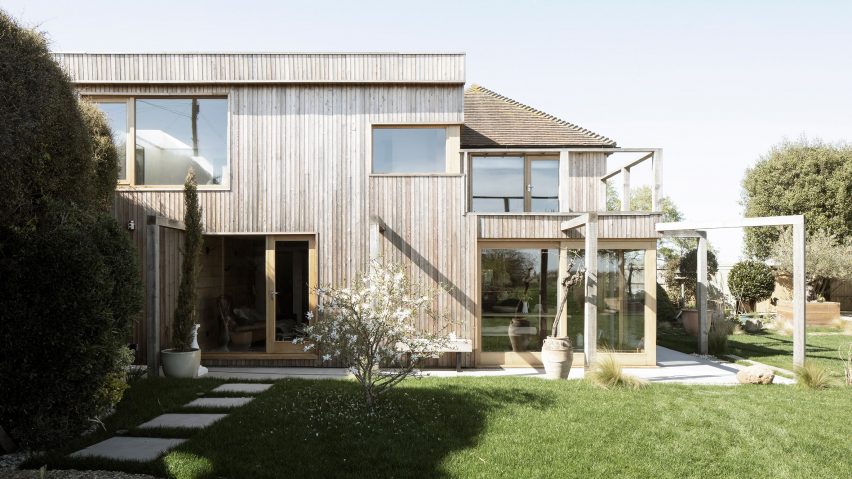Paul Cashin Architects has refurbished and extended a 19th-century cottage in Sussex, England, cladding the old and new buildings in larch.
Built in 1830, Island Cottage is in a conservation area in the seaside village of Sidlesham Quay and was highlighted by the local authority as a key example of rural character for homes in the area.
The renovation by Hampshire-based Paul Cashin Architects aims to combine building's traditional vernacular with some contemporary design elements.
The new timber structure is directly connected to the old house and built in its large back garden, so isn't visible from the street.
Traditional building methods and materials were used to reinforce relationships with the local architecture. The original facade was left plain, but the external walls at the rear were all been clad with natural larch planks.
Timber loggias mark the terrace around the extension while a small rooftop garden has been planted with native grasses, to create a relaxing space with views over the neighbouring Pagham Nature Reserve.
"The occupant will encourage vines and creepers to grow up each post and beam back to the house, which over time will further set the house into the landscape," explained Oliver Cradock from Paul Cashin Architects.
Because the old building had been extended many times, the original cottage had become a maze of rooms and corridors. The renovation sees the layout simplified.
"Our first move was to establish the lines of the original cottage and draw a single route through the house. This is experienced as a simple door from the library at the formal end of the house, leading from north to south straight towards the rear garden on both floors," Cradock told Dezeen.
"By reinstating the library and guest bedroom spaces above, we were able to distinguish the original cottage from the later additions."
The ground floor contains a library, a shower, two rooms and a long, open space with kitchen and dining area. The first floor hosts three bedrooms, a bathroom and a living room.
In the main living space, a corner window has been set into the wall at desk height. Its shape was chosen because it looks like an open book.
"The owners likes to read, so the spaces have reading positions in most rooms – chairs or cushions with blankets and reading material always within reach," he added.
For the interiors, the architects used natural materials from the surrounding coastline, such as flint and reclaimed oak timber.
Vintage furniture and accessories collected by the owners in antique stores, flea markets, salvage yards and online second-hand boutiques are displayed throughout Island Cottage.
"The house is decorated with reclaimed materials, referencing the worn and weary effect of time spent on the beach or at the seaside," said Cradock.
Because Sidlesham Quay is in a flood zone, all new construction had to be able to withstand rising water and flood damage.
"We created a bund of earth and site material, and allowed grass to take hold over the top. This is one of several steps to stop water from moving into the grounds of the property," explained Cradock.
Another flood protection measure is land drains that connect to the Sidlesham Quay itself, to alleviate surface run off. The kitchen furniture is made from plywood, rather than MDF, so if it does get wet it won't leak toxic glue fragments into the reseeding water.
Rooftop gardens are an environmentally friendly choice for coastal buildings, which often have delicate ecosystems.
In Connemara, Ireland, Tierney Haines Architects planted a lavender bushes on top of a writer's study, and in Sydney, Australia, ArchiBlox covered a clifftop house in greenery to help it blend in with the landscape.
Photography is by Richard Chivers.

